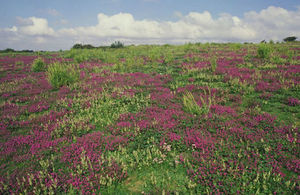Help wildlife thrive in East Sussex’s Nature Reserves
Natural England is calling on the public to donate to a campaign to help restore East Sussex NNRs

An image of a green field with purple flowers.
Natural England is calling on the public to donate to its campaign to kick start the recovery of essential wildlife habitats on National Nature Reserves (NNRs) in East Sussex.
Donations will help to improve the condition of these nationally significant sites and increase their value to both wildlife and the local community.
East Sussex NNRs which will benefit include:
- Castle Hill NNR - one of the finest examples of ancient, wildflower-rich chalk grassland sites in the country. Of the 58 UK species of butterfly, 31 have been recorded on Castle Hill, including Adonis blue, chalkhill blue, small blue and silver spotted skipper.
- Lullington Heath NNR - one of the largest areas of chalk heathland remaining in Britain. Over 250 types of plant grow here and more than 98 types of bird have been seen, 50 of which nest on the reserve.
- Pevensey Levels NNR which lies in the heart of a large grazing marsh home to many species of wetland birds as well as 20 species of dragonfly and damselfly.
All these nature reserves require continued management to ensure that the important habitats for which they are designated are maintained and expanded. With public support, Natural England can continue to protect, improve and increase the biodiversity of these sites.
Donations will help restore areas of chalk grassland and heathland which support populations of declining species such as the adder, grayling butterfly and wart biter cricket giving the local community NNRs to enjoy and be proud of.
Natural England’s Area Manager James Seymour said:
These sites encourage nature recovery by acting as a reservoir of wonderful habitats which, given a chance, will spill out into the wider countryside. They are special places that Natural England manage for the benefits of people both locally and nationally.
Our aim is to raise funding to support our work in restoring the grassland and heathland habitats that are the main feature of our reserves. In the early stages this work will focus on the clearance and restoration of scrub areas and allow us to manage the sites in a more traditional way.
Lee Gander, the Reserve Manager for Natural England’s East Sussex NNRs, said:
Public support will really help us in securing the long-term future of these fragile but increasingly important natural habitats.
While it can be difficult to work with limited budgets, with the opportunities that will come from securing this community support we can really start to turn the tide and give the area sites to be proud of.